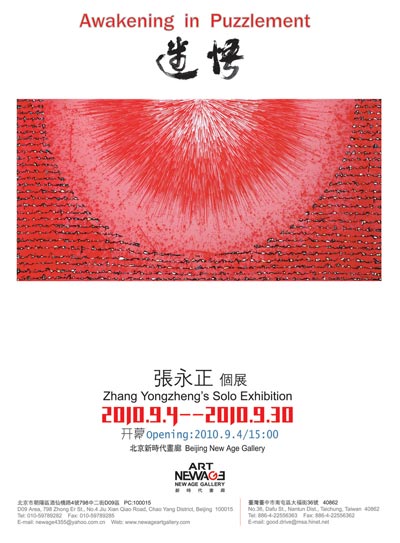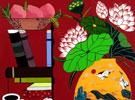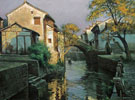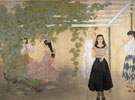
展览时间:2010-09-04 ~ 2010-09-30
展览地点:新时代画廊
参展艺术家:张永正
开幕时间:2010-09-04 15:30
展览介绍:
安德斯•格斯塔森曾说:“张永正的艺术,植根于中国传统和思想模式,他把自然宇宙的点点滴滴都纳入到作品中,既关乎人类的物质家园,又涉及形而上的世界。今天,在中国当代艺术的多元景观中,有谁能够代表中国艺术的新面貌?每当我静下心来思考这个问题时,总会想到张永正。”
张永正,中国70后新一代艺术家。早在2008年,就以个展“玄律”,呈现出他独特的艺术语言和艺术观念。他的作品,以蕴涵书法之气自由抒写,以中国古代“五行观”赋色,以中国古人哲学思想观照万物,呈现出一种阴与阳、天地与自然、心灵与宇宙间的循环、活跃、至动而有韵律的艺术境界。他从中国传统文化中寻求人与自然的契合、“天人合一”的观念,以此来观照当下:对现代人的生存与存在、人与自然和谐共存,进行一种终极的关怀思考。
即将于2010年9月4日举办的个展“迷悟”,将集中呈现他近几年来艺术创作的持续和推进。“迷悟”,按艺术家自己的说法:首先,它是一对阴阳关系,迷与悟之间是对立的,相反的。‘迷’对应着‘阴’,好比黑夜、黑暗、模糊;‘悟’对应着‘阳’,好比白天、光明、清晰。其次,迷悟,即迷惑与觉悟。迷:分辨不清,失去判断能力,迷失,迷惑;悟:觉醒,醒悟,大彻大悟。再次,从迷到悟,是一个过程,是精神升华的过程,是人生之路成熟的过程,是黑暗到光明的过程,也是修行者所追求理想的过程。最后,从我的创作而言,也是一个从迷到悟的过程。我从2005年以来,就以“过程” 系列进行创作,至今,已延续到“过程系列6”。《过程》系列,也是指从迷到悟的时间过程。我画面中的线也寓意着迷,但又指向通往觉悟的路。从迷到悟是艰难的,需要我们东方的传统文化和自身的行为规范。我期望我的生活与艺术踏上觉悟之路。
“我们所生活的这个时代,是一个虚幻的、迷幻的世界。所谓的繁荣,有时只是一种假象。现代人所追求的世俗的物质理想,都是因为精神所迷,是非不分。种种灾难都与人类的“迷”有关,多数人也没有觉悟的意识,人与自然、人与人之间的不和谐,也因为迷。解决我们所面临的问题与灾难,需要的是觉悟,醒悟。迷与悟,都取决于意念。”(张永正)
在他最近完成的一批新作中,那一贯流动绵延的力线的律动,沉静而充满生机的画面,却似乎被一种生成于混沌中的力突然冲破,呈现着“大爆炸、大冲撞”的视觉形态,给予人们的心理与视觉,一种强烈的不适和动荡感。由此,他的绘画,从以前所潜存着的一层深深的静寂,转而变得充满着动荡与不安,仿佛预示着一种灾难或危机的到来。也许,当代中国社会和整个世界所发生的巨大变化,会随之影响到中国人的宇宙观,这些作品可以说是他敏锐的个人感受,也可以说是艺术家在自己的美学世界中的新发现,预示着一种新的艺术语言的诞生。
有人说古希腊哲学家们最大的贡献,是把“自然”看作为没有人类存在的宇宙。然而,中国的先哲却认为,人与自然不可分离,是一个整体。因此,中国哲学史上,大部分的哲学家都在探讨人类如何努力寻找和保持二者间的平衡。而在艺术中,中国的艺术家张永正,亦做着同样的探索。
“His art is thoroughly rooted in Chinese tradition and thought patterns … It contains a whole universe–both the outer and the inner … When I’ve pondered on the question of which art could be seen as representing a different China on the multifaceted scene of Chinese contemporary art, one of the names that keep popping up in my head is Zhang Yongzheng,” commented Anders Gustafsson.
Zhang Yongzheng, an artist of the new generation of the seventies, impressed the public with his clear and unique understanding of art and style at his solo exhibition Mysterious Rhythm in 2008.
The works build up an artistic realm based on the cycle, movement and rhythm of Yin and Yang, the sky and earth and nature, the soul and the universe with calligraphic free expression, “Style of Five Elements” in coloring, and reflections in the framework of ancient Chinese philosophy. Thousands years today, we forget how our ancients followed the principle of the unity of time and space, unity of the universe and man and lived in harmony with nature. The artist, by trying to identify the connection between man and nature in traditional Chinese culture and its theory of “unity of the universe and man”, reflects on our world with his ultimate concern for human reality and harmony between man and nature.
His solo exhibition Puzzlement and Awakening, to be held on Set. 4, 2010, is aimed to be a concrete exhibition of the artist’s progress made in the last three years. Belonging to Yin and Yang respectively, “puzzlement and awakening”, as is explained by the artist himself, are in opposition to each other, i.e., “puzzlement”, like night, darkness, and vagueness, corresponds to Yin, while “awakening”, like day, light, and clarity, corresponds to Yang. Then, “puzzlement and awakening” mean “perplexity and awakening”. When one gets perplexed, he/she is disoriented and loses his capacity of judgment. Moreover, from puzzlement to awakening one gets his soul purified, his goal in life cleared, and experiences the change from darkness to light, so the process is also a pilgrim’s progress. Last but not least, doing these works of art, I went through the same process— from puzzlement to awakening. I started Process series in 2005, and now I am doing Process 6. This series records such a process. The lines in the paintings are surely symbolic of puzzlement, but they lead to awakening. It is not easy to liberate ourselves from puzzlement and stay awake, and we have to turn to traditional culture in the East and self-discipline. I wish both my life and my art can reach that state.
“Our age is dominated by illusions and obsessions. The so-called prosperity can sometimes be deceptive. Modern man are spiritually lost and confused, so they are in relentless pursuit of material riches. Disasters in various forms all have something to do with our “puzzlement”. Due to puzzlement, most people do not know they have to awake, and there is lack of harmony between human beings themselves and between man and nature. It takes awakening to solve the problems and disasters we are facing. To stay in puzzlement or to stay awake, it depends on our will.” (Zhang Yongzheng)
In his latest works, the flow of lines in most of his works (implying movement in the universe, i.e., movement of life, also rhythm of life based on the eternal exchange between Yin and Yang) seems to be suddenly interrupted by a force from the world of chaos, producing the visual effect of the “Big Bang”, leading to strong visual and psychological uneasiness and turbulence. Here the underlying absolute stillness in his previous works is replaced by an overwhelming sense of unrest, evoking a sense of imminent disaster and peril. The great changes in Chinese society will probably influence the Chinese view of the universe. These works maybe considered a mirror of his personal reflections, and more importantly, revelation straight into his own aesthetic universe, heralding a new form of expressional language.
Someone pointed out that the greatest invention by Greek philosophers was to single out “nature” as being universe without man. The Chinese, though, saw man as inseparable from nature, as part of a whole. Much of Chinese philosophy is an inquiry into man’s struggle to find and maintain the balance. In the realm of art, Chinese Zhang Yongzheng is engaged in the same pursuit.
- 2011-04-30 ~ 2011-05-30出窍记·缪晓春个展
- 2011-04-29 ~ 2011-05-20静中人Figures of Silence —Michel Madore
- 2011-04-30 ~ 2011-05-14黑白
- 2011-05-28 ~ 2011-07-28四重奏——孟昌明水墨荷花作品展
- 2011-05-28 ~ 2011-06-24“远与近”意大利当代著名艺术家作品展
- 2011-05-28 ~ 2011-07-02底下有石头:杨心广个展
- 2011-05-21 ~ 2011-06-20湖滨诗境──Celest生态摄影展(续展)
- 2011-05-21 ~ 2011-06-05缓行——十二位八零后艺术家
- 2011-04-28 ~ 2011-06-05观天悟道——张国龙艺术巡展
- 2011-05-28 ~ 2011-07-10诺特·维塔尔:激浸










